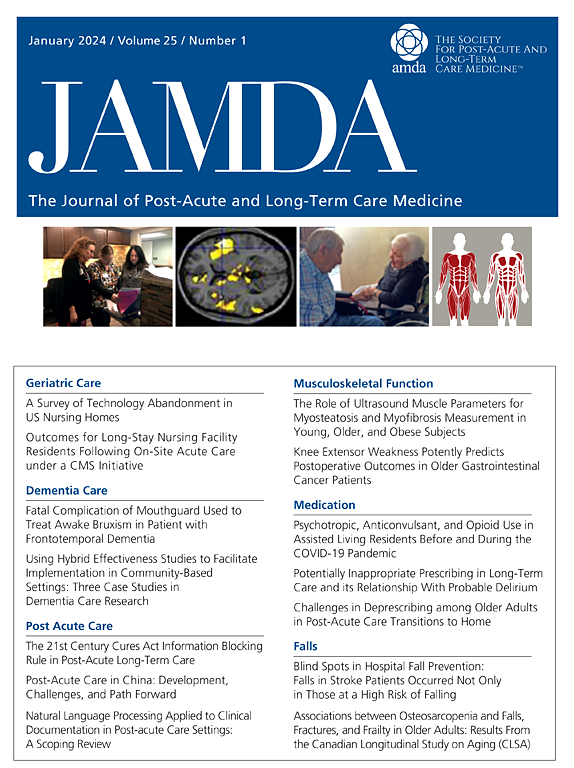Defining and Categorizing Nonpharmacologic Interventions in the Older Population: A Systematic Review
IF 4.2
2区 医学
Q2 GERIATRICS & GERONTOLOGY
Journal of the American Medical Directors Association
Pub Date : 2024-10-16
DOI:10.1016/j.jamda.2024.105306
引用次数: 0
Abstract
Objectives
Nonpharmacologic interventions (NPIs) constitute an important part of treatment for older adults, cover a broad and diverse range of interventions, and have advantages over pharmacologic interventions (eg, limited adverse side effects). However, an unambiguous definition of NPIs is still lacking. Defining NPIs may facilitate research on this topic and enhance comparability of results between studies, and might help to face the challenges of recognition, acceptation, funding, and implementation. Therefore, the aim of this review was to provide an overview and comparison of the definitions of NPIs used in the current literature on older adults.
Design
A systematic review was performed to provide an overview of the definitions of NPIs that are used in the current literature on older populations and to organize the characteristics involved in the definitions.
Setting and Participants
People ≥60 years of age were included, not limited to a specific setting.
Methods
A systematic search was performed in the following 5 databases: PubMed, Embase, Clarivate Analytics/Web of Science Core Collection, Cumulative Index to Nursing and Allied Health Literature, and Wiley/Cochrane Library. The time frame within the databases was from inception to December 4, 2023. Review articles, editorials and consensus papers were included.
Results
We included 28 articles. We organized the definitions of NPI according to 4 different aspects: types of interventions involved, target population, goals the interventions addressed, and requirements of the interventions. Definitions in the current literature can generally be divided into 2 groups: NPIs described as not involving medication, and more elaborated multidomain definitions. Based on the results, we formulated criteria for types of interventions that can be considered an NPI.
Conclusions and Implications
Using current descriptions and characteristics, elements for a new definition for NPIs were proposed. To improve research in this field, consensus needs to be reached regarding elements covered by a definition of NPIs.
界定和分类老年人口中的非药物干预措施:系统回顾。
目的:非药物干预(NPIs)是老年人治疗的重要组成部分,涵盖广泛且多样的干预措施,与药物干预相比具有优势(例如,不良副作用有限)。然而,目前仍缺乏对 NPI 的明确定义。定义 NPIs 可促进对该主题的研究,提高研究结果之间的可比性,并有助于应对认可、接受、资助和实施方面的挑战。因此,本综述旨在概述和比较目前有关老年人的文献中使用的 NPI 定义:进行系统性综述,概述目前有关老年人口的文献中使用的 NPI 定义,并整理定义中涉及的特征:包括年龄≥60 岁的人群,不限于特定环境:方法:在以下 5 个数据库中进行了系统检索:方法:在以下 5 个数据库中进行了系统检索:PubMed、Embase、Clarivate Analytics/Web of Science Core Collection、Cumulative Index to Nursing and Allied Health Literature 和 Wiley/Cochrane Library。数据库的时间范围从开始到 2023 年 12 月 4 日。结果:我们收录了 28 篇文章。我们根据以下 4 个不同方面对 NPI 的定义进行了整理:涉及的干预类型、目标人群、干预所针对的目标以及干预的要求。目前文献中的定义一般可分为两类:描述为不涉及药物治疗的 NPI,以及更为详尽的多领域定义。根据研究结果,我们制定了可被视为 NPI 的干预类型的标准:利用当前的描述和特征,提出了 NPI 新定义的要素。为了改进这一领域的研究,需要就非营利组织定义所涵盖的要素达成共识。
本文章由计算机程序翻译,如有差异,请以英文原文为准。
求助全文
约1分钟内获得全文
求助全文
来源期刊
CiteScore
11.10
自引率
6.60%
发文量
472
审稿时长
44 days
期刊介绍:
JAMDA, the official journal of AMDA - The Society for Post-Acute and Long-Term Care Medicine, is a leading peer-reviewed publication that offers practical information and research geared towards healthcare professionals in the post-acute and long-term care fields. It is also a valuable resource for policy-makers, organizational leaders, educators, and advocates.
The journal provides essential information for various healthcare professionals such as medical directors, attending physicians, nurses, consultant pharmacists, geriatric psychiatrists, nurse practitioners, physician assistants, physical and occupational therapists, social workers, and others involved in providing, overseeing, and promoting quality

 求助内容:
求助内容: 应助结果提醒方式:
应助结果提醒方式:


